Human Flower Project
Tipping The Scale In Kentucky
By on February 28th, 2022 in
Tipping the Scale in Kentucky
Allen Bush reports from the state fair on donut burgers and leaking pumpkins—the next best thing to being there. Thank you, Allen!
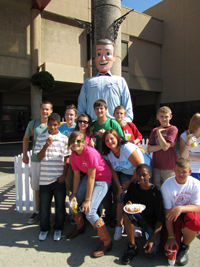 FFA members from John Hardin H. S., Radcliff, KY, greet Freddy Farm Bureau, a fixture of the state fair
FFA members from John Hardin H. S., Radcliff, KY, greet Freddy Farm Bureau, a fixture of the state fair
Photo: Allen Bush
By Allen Bush
Country folks and city folks meet every sweltering August at the Kentucky State Fair in Louisville for corn dogs, horse shows, games of chance, beekeepers and bumper cars. You can count on donkeys and the Oak Ridge Boys each year, too. The fair just wouldn’t be the same without big Asses and Elvira.
Notions of healthy Kentucky grown produce – and there is plenty around in local farm markets – are pushed aside for ten days of corn dogs, snow cones, funnel cakes and elephant ears. (A delicious beef brisket barbeque was the closest thing to Pritikin I could find.) The atherosclerotic-inducing donut bacon cheeseburger was this year’s sensation. Add an order of chili cheese fries and you could clog the next oil spill. (You wonder why, in all of “Fast Food Nation,” no one ever came-up with a donut bacon cheeseburger before, and then you’re reminded that it took 5,000 years for someone to put wheels on a suitcase.)
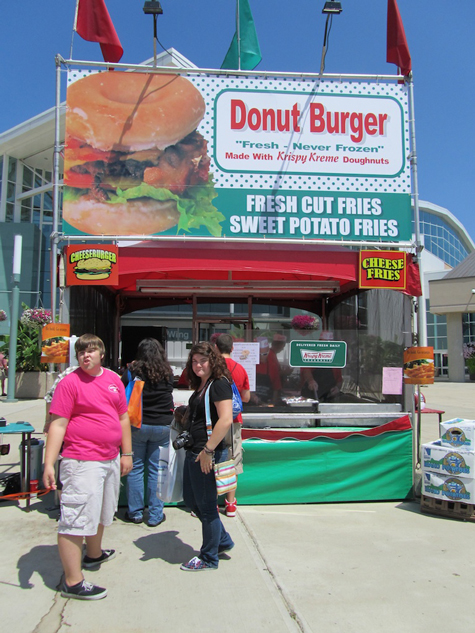
Standing in line for a donut cheeseburger, the toast of the 2010 Kentucky State Fair
Photo: Allen Bush
Neither horses nor tobacco (not even fried food) come close to the pumpkin’s historic significance in Kentucky agriculture: Pumpkin’s kin were here first. And in 2010 the Largest Pumpkin Contest carried a lot more weight than Farm Bureau Freddy, the eighteen-foot-tall mascot who’s been sitting ram rod stiff on hay bales, greeting fair goers outside Freedom Hall for fifty-three years. The oldest archaeological remains of pumpkin – over 10, 000 years old – were found in Guilá Naquitz Cave in Oaxaca, Mexico. (Incredibly, the oldest known corncobs (Zea mays), dating back 6,000 years, were found in the same cave complex at Guilá Naquitz.)
But an important clue to one of the possible ancient pumpkin’s kissing’ cousins, if not a direct progenitor, was found in Kentucky. Seeds of an ancient gourd were found in the Red River Gorge in Powell County, Kentucky, fortuitously preserved in the dry environment of a rock shelter. (Cucurbita pepo, a New World species, includes squash, yellow-flowering gourds and pumpkins. Cucurbita pepo subspecies ovifera is the pear gourd; Cucurbita pepo subspecies pepo is the pumpkin.)
It was first presumed those seeds found in Kentucky had been domesticated, selected over millennia for improved performance, by indigenous people. But according to research published in the Journal of Ethnobiology by C. Wesley Cowan and Bruce D. Smith (1993), these were wild seed and represented one of the most eastern U.S. locations of subspecies var. ozarkana. Carbon dating tests confirmed that the Kentucky discovery of the Red River Gorge material was 4,500 years old.
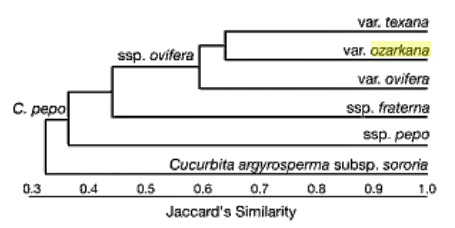
Pumpkin genealogy?: Cluster analysis of taxon means of Jaccards’s Coefficient of Genetic Similarity values among infraspecific taxa of Cucurbita pepo and C. argyrosperma.
Fig.: Deena Decker-Walters, from Documenting Domestication by Melinda Zeder
(The trail diverges here: More recent mitochondrial DNA studies suggest the possibility that subspecies ozarkana, may have been the progenitor for subspecies ovifera. And subspecies ovifera, according to mitochondrial DNA, could have given rise to the pumpkin. It’s all a guessing game of haplotypes. In all likelihood, there were two probably distinct genetic lines.)
Well alright. The pumpkin probably took shape in Mexico, and not Kentucky. But at least we had a historic role, as small as it may be, along a long trail of pepos. And the important discovery of prehistoric seeds of Kentucky’s native gourd predated the domestication of gourds by 2,500 years. Kentucky was at the center of early plant domestication. (And Wes Cowan found a new niche, a few years ago, on Public Television’s The History Detectives.)
Which brings us to the Large Pumpkin Contest at Kentucky State Fair —a big deal.
Jimmy Sowers, a school bus driver, lives near Stanford in Lincoln County, Kentucky. He’s been tinkering with giant pumpkins for three years. He drove to Louisville with grandson Jansin and sat impatiently at a corner table, eyeballing the competition, a half-hour before the Large Pumpkin Contest. Frank Mudd from Flaherty, KY, in Meade County, is Kentucky’s godfather of big melons and pumpkins. He didn’t have anything for this show. His giant pumpkins, “just quit growing in the heat,” he said. Mudd still had plenty of reason to be proud. He has won the pumpkin contest 6 times, and has been the defending champ the last two years. He’d also won the big watermelon contest the day before with a 224-¼ pound whopper – the biggest in the state’s history. Terry Meiners, afternoon drive-time host on WHAS radio and emcee of the contest, introduced Mudd as a “pumpkin growing legend.”
Mudd liked the look of Sowers’s entry. “It comes down to good luck with weather, genetics, the right ground and stuff like that,” the champ said. Mudd knew a couple of pumpkins at the fairgrounds were getting a little “tired.” Dwight Slone of Prestonsburg, Kentucky, who holds the state pumpkin record of 1,278 ½ lbs, was here. (The world record of 1,725 lbs is held by Ohio’s Christy Harp.) Slone had entered his Kentucky State Fair entry in last week’s Indiana State Fair. Pumpkins lose water weight every day, but while they are actively growing they can add 35 – 40 lbs a day. A dollar per pound was being offered to the contest winner with one simple proviso: it had to reach one thousand pounds.
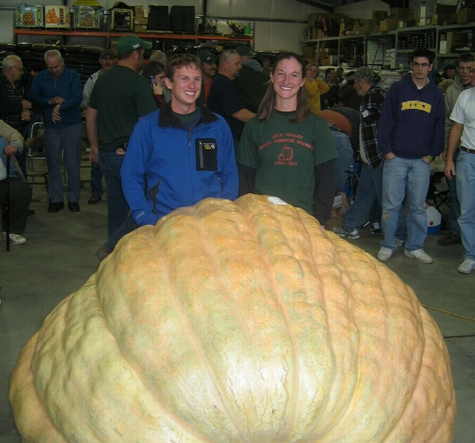
Ken and Christy Harp with Christy’s world-record-setting pumpkin—1,725 lbs.
Photo: Courtesy of Pam Diffenbaugher
The first two pumpkins were little more than jack o’lantern-sized, weighing in at 18 ½ and 79 ½ lbs. Sowers sat back taking it all in. He’d brought a serious contender but didn’t know if his would tip the scales at more than 1,000 lbs. The next entries – big ones, indeed – had to be hoisted to the weigh-in by a crew of four who carefully attached straps to a front-end loader. John Thompson of Pleasure Ridge Park, near Louisville, didn’t embarrass himself. His hit the scales at 669 lbs. Dwight Slone was up next with his traveling pumpkin.
The Kentucky Pumpkin Mafia strikes fear with Hoosiers. The ground warms up sooner south of the Ohio River and that gives Kentucky growers a head start. Last year’s Indiana winner was John Van Hook of Somerset, Kentucky, whose mighty pumpkin hit the scales at 1145 lbs. But the Kentucky summer heat played havoc in the build-up to this year’s Indiana State Fair. A Buckeye, Samuel Durst of Piqua, Ohio, trumped the Kentucky Pumpkin Mafia with a hefty 1,106 pounder. Slone’s pumpkin could only muster 873 lbs and finished 6th. Kentuckians were shutout in Indiana for the first time in two years. By the time Slone weighed-in a week later in Louisville, the Prestonsburg pepo had shed 9 1/2 lbs.
Jimmy Sowers finally stood-up. Frank Mudd, the gracious reigning champion, whispered that he thought Sowers might win. Sowers started seeds in late April and lined-out the plant on the 10th of May after any danger of a late frost. It was vital to get the soil tested, to “get it right,” he said. Right on was a sweet spot pH between 7.0 and 7.2. Some growers will use nighttime lighting and heat cables. Others will set-up little tent-like greenhouses to absorb heat and retain some on cool spring nights. The long hot summer kept Sowers busy with the hose. His thirsty behemoth soaked-up 19,000 gallons of water like a sponge. The pumpkin was harvested the afternoon before the contest, “as late as I could,” Sowers said, and was loaded on the back of his pick-up with a front-end loader.
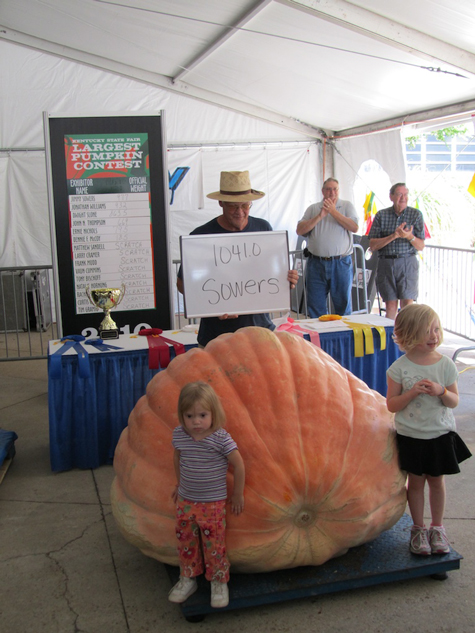
Jimmy Sowers and gourd-aids: his pumpkin won this year’s contest at the Ky State Fair
Photo: Allen Bush
The Fair crew delicately moved the Lincoln County pumpkin closer to the scales. Sowers moved-in closer. Terry Meiners, hoping for a thousand pounder, watched as it landed softly on the scale. Meiners announced: “977 lbs!” There was a brief collective sigh. This wasn’t quite a thousand pounder. “But, wait, “Meiners interrupted, “there’s a late addition.” He looked around the crowd of nearly one hundred, spotted two young girls, and asked them to come forward and stand on the scale with the pumpkin. “We have a winner…1041 lbs!” Meiners had maneuvered quickly, not wanting a few pounds to interfere with a good show. Jimmy Sowers smiled, accepted the blue ribbon, trophy and the check for $1,041. The water bill would be paid.
Comments
Georgia,
I never asked whether these big pumpkins were tasty. I should have! Besides saving seeds from the biggest each year – for sowing the next – I suspect they are grown for bigness and little else.
I had not seen the Edible Geography blog before. I checked it out and enjoyed the piece on Nomencloneture. Thanks for sharing that.
i can’t believe it is fair season already. but of all the giant produce / pumpkin contest related stories that will come out this fall, it will be hard to beat this jackpot story. So good. keep it up!
Thanks, Victor. The Buckeyes seem to have an edge this year. The Pumpkin Festival in Circleville, Ohio on October 19 – 23 looks to be a big one
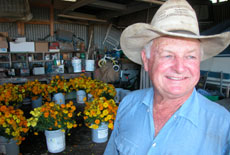

Are these heavy weight pumpkins tasty?
Hopefully the two “gourd-aids” will go on to love fresh produce and eschew food products like doughnut bacon cheeseburgers!
p.s. Are you familiar with the Edible Geography blog?